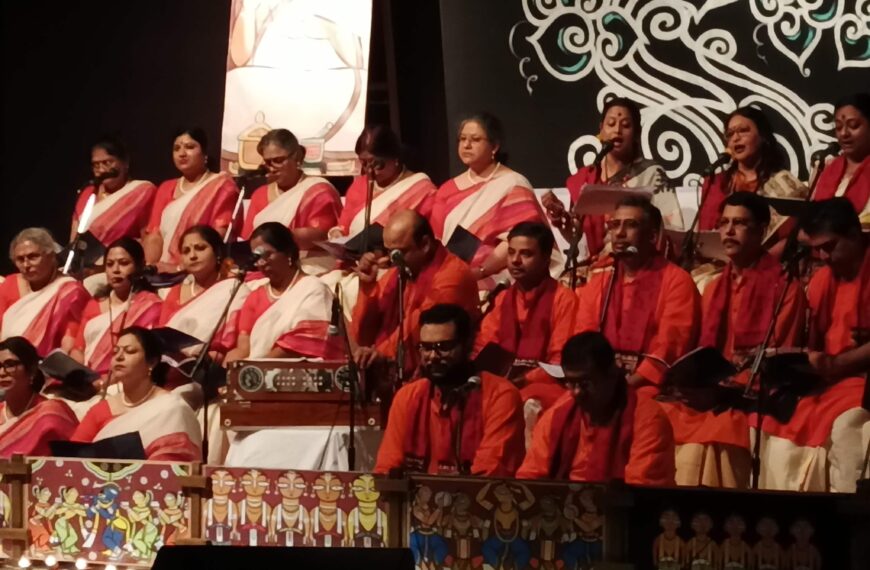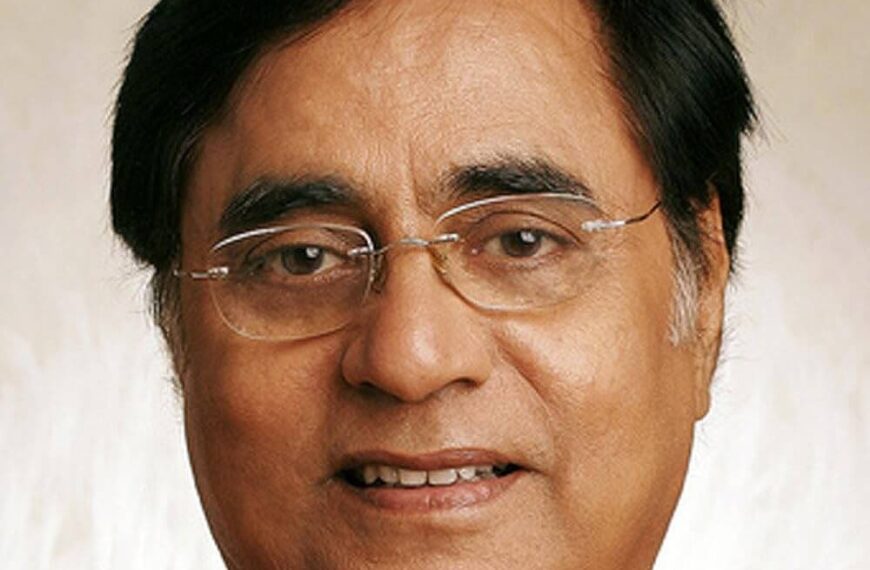Ruchira, in a candid interview with Rabindra Sangeet exponent Srabani Nag, who is also a mathematics teacher. An exclusive for Different Truths.

Singer Srabani Nag has completed twenty-five years (and still counting) in the Rabindra Sangeet circles of Kolkata (read Bengal). A B-grade Kolkata Doordarshan artist, Srabani is also visible on other Bengali channels. A Vishwa Bharati Music Board ‘approved’ artist, she judges numerous live musical competitions. She has cut several audio albums, which are doing well. Having relocated to the National Capital Region (NCR) a few years ago, Srabani is creating ripples in local Bengali localities via offline and online programmes, directing and participating in them. Lately, she completed a piano course that will doubtlessly enhance her musical calibre.
I was familiar with her name, having casually watched a few of her music videos online. That is until my sister, who happens to be her guru bhai (both trained under Ashish Bhattacharya), made the introductions.
Upon reaching her home in an exclusive high-rise in Noida, she greeted us with a broad smile and Namaste. We were escorted into her cosy studio-cum-library, where a lively interaction began.
Sraboni possesses a voice as elusive as the strains of a flute. There is an element of pathos in her rendering that stirs the depths of emotions. Surprising that the limelight has been with her for a long time. Lines from Grey’s Elegy In A Country Churchyard come to mind:
“Many a gem of purest ray serene
The dark unfathomed caves of ocean bear….“
Success has come to her relatively late, but Srabani remains unruffled, marching ahead with a smile and a song on her lips.
Could you tell us about your early years? Did music come to you naturally?
Oh, yes! I was born into a family steeped in culture and performing arts. My mother was a guitarist; my father was associated with stage theatre. I have three older sisters. The oldest is an alumnus of Gitobitan, a premier musical institute in Kolkata. The second is a gold medalist postgraduate guitarist, while the third is a postgraduate in music from Rabindra BharatiUniversity Kolkata. As a child, I would often accompany my Bardi (oldest sister) to her classes, sit quietly while the classes were on, listen, and imbibe whatever little I could regarding the nuances. My sisters took musical tuitions and practiced their coursework at home; I would listen and learn from them. There were vigorous classical music sessions at home, which helped me assimilate music. Later, Ashish Bhattacharya heard me sing and discovered my latent musical talent. It is he who suggested I must have proper formal training. So, I was admitted into Gitobitan.Thus, my musical journey began.
A mathematics teacher or singer – how do you juggle the two? Also, is there a link between mathematical formulae and music notation?
Strangely enough, besides singing, I have been a mathematics teacher at school all my life. Many people enquire as to how I manage to juggle mathematics and music. Consider this. Einstein, the renowned scientist, was a great friend of Tagore. Likewise, there exists a deep link between mathematics and music. Each song comprises Chanda (rhythm) and Taal, calculated beats of 3:3 or 4:4; even where beat/meter is missing (implying taal chhara), the rhythm is intact. This, in a nutshell, is mathematics. Those who dabble in these subjects can easily perceive how music is connected to mathematics.
Which aspects and themes of Tagore appeal to you and figure in your works?
In the domain of Rabindra Sangeet, my forte is Dhrupad and Tappa. Tagore based a considerable number of his lyricson these two genres. Earlier, I dabbled in the baul category too. I enjoy experimenting with diverse themes that interpolate Tagore’s works. I have worked on themes like usingthe flutein Tagore’s works. The strains of flute aptly depict myriad emotions viz joy, sorrow, melancholia, Radha-Krishna relationship, and more. I also staged Parboni – an anthology of social /community festivals started by Tagore. These include Maghotsav (Winter fiesta), Sharadotsav (Autumn festival), Basantautsav (Spring festival), etc., with a smattering of ceremonial occasions unique to the Brahmo Samaj. Another favourite theme is Borshaye Birohini nayika (gloomy moods of a lovelorn Nayika), as portrayed in innumerable songs and ballets composed by Tagore.
What is music, especially Rabindra Sangeet, to you?
Rabindra Sangeet is my life’s breath, and Tagore is my Jeevan Devata (Lord of my life). I can’t imagine living without Rabindra sangeet. Each song became more meaningful as I grew up and underwent manifold experiences. Tagore’s songs invariably usher in a unique philosophy, a healthy culture, and excellent tastes.
You have led some musical troupes. Please elaborate

After graduating from Gitobitan, I had my first audition at Rabindra Sadan. After that, I began performing in Mukta Mancha. I started a group, Amader Prayas. Under the aegis of ICCR, we presented topical programmes viz Surer Utser Sadhana (back to the roots), Koto Ajanaare (discovering strangers), Dwande Chhonde (songs with similar tunes yet distinct identity), Bhaanga Gaan (transmogrified tunes) and many more We also had a group, Nandini, wherein we staged Tagore-centric pieces. My partner Hina Bagchi taught dance while I handled the songs.
I feel our best presentation so far is that Rajendra Nandini is portraying two characters created by Tagore – Chitrangada and Kamalika – both princesses yet so strikingly different. The musical narrative depicts how both realise through experience that physical beauty is fleeting; only love, and intrinsic worth are intransient.
Also, Sraman, my NGO, identifies musical talent in individuals hailing from EWS and provides them primary education, honing their musical skills for their future growth and development.
I maintain a Facebook page titled Sahachari (friends), which in tandem with Delhi Bengal Association, highlights events commemorating Tagore’s birth and death anniversaries.
Currently, I run a weekly online show Amaar Addaghar popular among the Bengali diaspora in Delhi-NCR and elsewhere.
You learnt music under the tutelage of Ashish Bhattacharya, a living legend. Please tell us about him.
My mentor (guru) Ashish Bhattacharya is a prominent disciple of the colossus (late) Sailajaranjan Majumdar, a close associate of Tagore and a cornerstone of the Santiniketan style of music. At present, he is ranked among musical stalwarts based in Kolkata. He has had an illustrious career as the principal of Gitobitan. After his retirement, he is now into teaching music privately. He happens to be an eminent member of the core committee of Rabindra Sadan, which functions under the aegis of the Rajya Sangeet Parishad, West Bengal. Ashish specialises in rendering Dhrupad-based songs. He prefers to sing Tagore’s unfamiliar, low-profile, not-so-popular ditties. And he has determinedly inculcated this trait in all his pupils. You will find this in all of us.
Hindustani classical music is the backbone of music. Did you have any formal training in it? How does it help?
This is the absolute truth. Without proper voice training, your voice will lack flexibility. Without flexibility, singing is futile. It’s as simple as that. As mentioned earlier, I was trained in classical within the precincts of my home. As we know, Tagore himself grew up in an ambience of classical music. Luminaries of that era like Jadu Bhatta and Srikantha Singha regularly coached men of the household. His training in classical music enabled Tagore to use permutation and a combination of ragas in his compassion. To understand Rabindra Sangeet, you must realise Tagore’s interplay of ragas within the space of the same song and how he nimbly glides from morning to afternoon to evening ragas. And this can’t be achieved without basic training in classical music.
Do you have any dreams?
It is crucial to be a good human being, first and foremost, to be a good singer. I dream of getting increasingly involved with Rabindra Sangeet, propagatingit among a largeraudience, teaching more and more students and inspiring more people to discover Tagore’s music’s joyful and enchanting world.
What do you think about the upcoming singers? Any advice to them?
Several youngsters are doing very well and have already carved niches for themselves in the sphere of vocal music. Dr Utsab Das, Irene Sarkar, Iman Halder, Shishpiya, Arunabha Dasgupta, Aratrika, and Kaustubh Gowami are among the promising ones. My advice to all upcoming singers is to immerse yourselves in the study and comprehension of Tagore’s background of each song and, most importantly, all about the poet himself. A profound study of the notation is also essential. Endeavour to plumb the unfathomable depths of the lyrics, the subtle philosophy of each, the original ragas on which they are based, and the reason and circumstances behind their creation. Shed hollowness and imbibe profundity while you sing.
Photos sourced by the interviewer.






 By
By

 By
By
Sraboni is a close associate of mine. A very serious person who pursues her passion to the deepest .
Proud to see her delve through to fathomless thoughts of the Great creator.
Congratulations to her.